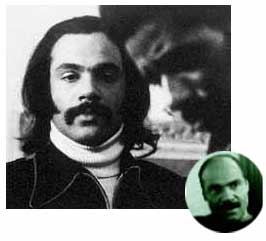 |
 |
||||||
|
January 19, 2004
Ron O'Neal, 1937-2004
Known to a generation of blaxploitation filmgoers as Youngblood Priest, the drug-dealing antihero of Superfly (1972), O'Neal was one of those actors in the rare (but perhaps unwelcome) position of instantaneously attaining icon status, even before he managed to attain a real career on screen. In the coming days we're sure to see obituaries for O'Neal that either take his Superfly role entirely too seriously or that, more commonly, frame it in the sort of ironically-racist inverted commas that encase—and obscure—so many blaxploitation films of the 70s. It's easy to watch a movie like Superfly and laugh at the occasionally stilted acting, the tricked-out 70s clothing, and the glorification of urban decay, but it's another thing entirely to see that O'Neal gave a great performance in that film. Make no mistake about it: Superfly is not a great movie. It's badly shot (by the late Gordon Parks, Jr., a photographer before taking up film like his father, Gordon, Sr. who directed Shaft) and Phillip Fenty's script, what there is of it, is as chopped-up and granular as the cocaine the characters inhale constantly. According to Darius James' That's Blaxploitation, it was shot on the streets during winter, using electricity siphoned from lampposts. The strongest scene, by far, is the mid-section montage of veritŽ-style still images depicting drug trafficking and consumption as a series of discrete moments of anxiety, ecstasy, and release: those stills show Parks most at ease as a director and the faces of the actors frozen mid-snort says everything the script leaves out. What sticks in your mind after watching the film are the details: the shots of New York City as it slouched into the seventies, a decade that would find the greatest American city on the brink of bankruptcy, awash in crime, and in some neighborhoods, literally burning to the ground; the kids sledding in Central Park; the funky chic (to echo Tom Wolfe's words) nightclub where Priest caught soundtrack composer Curtis Mayfield jamming; and other fleeting moments. Similarly, O'Neal's performance is made up tiny details: the way Priest licks the coke residue off his crucifix after taking a quick bump; his cadency delivery of certain lines; the palpable weariness and anger in O'Neal's eyes. (As Mayfield put it in "Ghetto Child," off the multi-platinum soundtrack: "Kinda mad, kinda sad...") Youngblood was more than a ridiculous Fu-Manchu mustache and wide-brimmed fedora. And O'Neal, an Obie-winning stage actor before being cast by Sig Shore in his little low budget exploitation flick, was much more than simply the guy from Superfly. As coincidence would have it, Superfly was released on a special edition DVD on January 13th, the day before its star died. Among its features is a short documentary from 1972 that shows O'Neal speaking eloquently about the "moral decadence" on display in Superfly, basking in the adoring attention of fans in Harlem, and running with his dog around the Central Park Reservoir. (In many ways, the documentary calls to mind the video-hagiography Amber Waves made about Dirk Diggler in Boogie Nights.) You can see that O'Neal is grateful for his fame and extremely modest about it. He tells us that his "success is, indeed, success for [his] people," and marvels at how he went from a little one bedroom apartment in New York to Hollywood almost overnight. Definitely not the sort of swaggering, alpha-male rhetoric you'd expect from Youngblood Priest. Since the release of Superfly (and its bizarre 1973 sequel Superfly T.N.T. which attempted to combine the blaxploitation crime genre with back-to-Africa politics), the term "Superfly" has become part of vernacular. That hasn't, however, prevented it from being misunderstood. In the documentary featurette, O'Neal tells us that the title has some "facetious sarcasm" to it, but that's not how it's been taken by the culture-at-large. In The Fight, Norman Mailer used it as a catchall for his fear and envy of Black people: How his prejudices were loose. So much resentment had developed for Black style, Black snobbery, Black rhetoric, Black pimps, superfly, and all that virtuoso handling of the ho. The pride Blacks took in their skills as pimps!… He could not really bring himself to applaud the emergence of a powerful people in American life—he was envious. They had the good fortune to be born Black. Quentin Tarantino, a self-styled "white Negro" like Mailer, used it to express Jules Winnfield's (Samuel Jackson) anger in Pulp Fiction : "Well I'm a mushroom-cloud-laying motherfucker, motherfucker! Every time my fingers touch brain I'm Superfly TNT, I'm the Guns of the Navarone!" Even the toe-headed dork from The Real World: New Orleans named his Web site Supa-Fly.com. None of these people quite gets what Superfly is about, mostly because they think it was a glorification of crime, ghetto nihilism, and machismo. It most certainly was not. It was all about, as one character said, "gettin' out of the Life," not the pleasure of that life. Rusty Cundieff's Fear of a Black Hat may have contained a parody of a gangsta rap video called "Gangsta's Life Ain't Fun," but only Superfly showed that. From being mugged by junkies who see you as a walking cash machine to being shaken-down by racist cops on the make, the Life was hell and O'Neal understood that: his Youngblood embodied it beautifully. Had he not died last week at 66, he may have had the chance to transcend Youngblood, but sadly, that opportunity is lost. Even as his image is destined to be slapped on 'ironic' T-shirts worn by skateboarders and used on flyers for every fraternities' "Superfly Saturday Night" party until the end of time, O'Neal is destined to retain his dignity because of his talent and the very real conviction he brought to his role in Superfly. He is survived by his wife.
Other Recent Items of Interest:
|
Make our "team" part of your "team"
|
||||||




